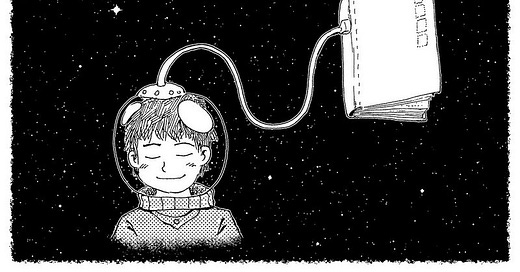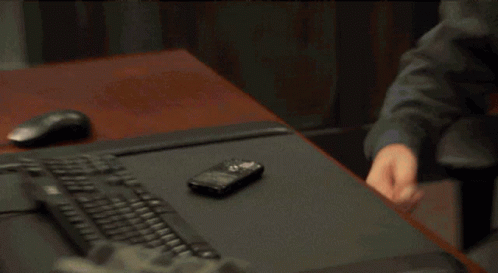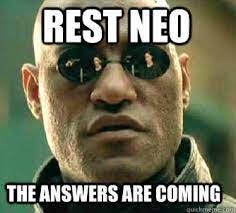Hi! This is an extra dollop of Everything Is Amazing, a science-based newsletter about curiosity, attention and wonder.
As I said a few days ago with this piece on the brain-bending delights of pareidolia, I’m on a between-seasons break, so this is a rerun from the early days of the newsletter (2021-2022).
But this one is something extra: a piece I’m squeezing in because it’s helped me stay focused for longer (in a way, it’s a sequel to this recent repeat edition on tuning out online clickbait nonsense).
So here’s some advice about reading emails, understanding goldfish, and defeating that ever-present urge to do this to your phone:
Firstly, thanks for reading, because email is so frequently awful. It should be marvellous, but…every day is overwhelming. (And it’s been years since I worked in an organisation! I probably have no idea how much worse it’s got.)
There’s still a side to emailing that I love. I have good friends I occasionally write long, rambling emails to, the kind Roxani is talking about here:


Now, you’d have to ask my friends if they enjoy receiving them. I’m too scared to do that. But writing them - it’s great for my mood and good for my soul, every single time.
It’s like those moments in the real world where you’re both sat comfortably and the sun’s high and the beer’s cold, and you just talk and talk, and suddenly it’s Wednesday. Or October. Whatever happens to the time in those moments, that is surely part of living a really good life. It’s what time should be for.
But with email, there’s also the Sisyphean grind of mucking out your Inbox every day, of “processing” rather than enjoying. Or you just give up, and start treating it like an informational landfill. In doing so, you miss everything - and the rot sets in. Friendly messages from people you’d like to know better go unanswered, and start to gather a weight of guilt and self-loathing that make them impossible to respond to without a 5,000 word apology that would even make Cheryl Strayed break out in a cold sweat…
But this is why Email Debt Forgiveness Day was invented! A yearly chance to pluck social redemption from the jaws of unending horror.
And it’s next month!
Here are the rules from the official website:
On September 30th:
Dig out the email you’ve been avoiding
Write a reply, ignoring the amount of time that has lapsed
Add a link to this page, you can even use this email template
Send and enjoy your anxiety-free day.
Listen to this episode of the podcast Reply All for the details.
Unfortunately, part of the problem here is reading anything online. Take this newsletter. Quite a lot of you aren’t reading this paragraph because it’s just too far in.
Based on previous open rates, I reckon maybe 50-60% of you opened this (although thanks to various Apple Mail updates, that’s going to get much harder for me to confirm in the future) and a good chunk of you have already thought “nah, not for me”.
According to a Nielsen Norman Group study in 2006, the average time that people read individual emails is 51 seconds. (I very much doubt it’s improved since then.) Since most of us read about 200 words every minute…well, over half of you are gone now. 😢
But it’s incredible that any of you are reading - hopefully not because this email is unusually rubbish, but because reading itself is such a thoroughly miraculous dance of sensory mechanics.
Take the following statement:
Apparently one in three Britons are conceived in an IKEA bed, which is crazy if you think about it because those places are really well lit.
(Copyright Mark Smith.)
Okay. If I asked you to describe the experience of reading that line, you’d probably say your eyes smoothly moved from left to right.
But they didn’t. That’s not how we read at all.
Reading is actually about two things, and the first is eye-jumping.
Your gaze leaps from place to place incredibly fast, an unending string of tiny hops - on average, less than a fifth of a second per jump.
(Try it. Look around you right now. Hop-hop-hop-hop-hop.)
These are called saccades - tiny movements caused by the squeezing and tugging of muscles in your eye. They’re astounding complex, not just because of the speed of them (which is startling) but because somehow, your eye always knows where to look next. It’s plotting future leaps and turning them into the electrical signals required to twist those muscles in just the right way to point your eye just so. Again and again and again. In other words, what we call “looking” is really a vast network of visual systems working together at unbelievable speed to…
Sorry. Forced carriage return. I felt that paragraph was getting too big. Your brain hates enormous unbroken blocks of text unless they’re really beautifully crafted, and I have no illusions about my work here.
(I also hope your mind hates those emails where every single sentence is its own paragraph, aptly nicknamed “broetry.” Gets wearying.)
Anyway. Saccades aren’t where you do your reading. They’re just the bits in between reading. During a saccade, your brain stops processing signals coming from your eyes, essentially switching them to standby mode. If they didn’t, your vision would be an overwhelmed smeary mess, an unending, pulsating Jackson Pollock of a thing that would drive you completely potty in minutes.
Very sensibly, your brain fudges this process, giving you the appearance of awareness while only collecting an undetailed “gist” of a glance to work with. It’s similar to how a Thatcherised Adele can play tricks on you.
In fact, almost all of the “seeing” part of reading only happens when your eyes stop. There’s only a ridiculously small part of your vision that’s capable of actual reading.
Hold your arm out in front of you, and do a thumbs-up. Your thumbnail? That’s the size of it. It ain’t big.
It’s called the fovea centralis, and it’s part of your retina. It’s tiny - and yet it’s the only place where you see with 20/20 vision (if you’re lucky to have such a thing), and can distinguish fine colour and detail. Nowhere else can do this.
I say again: it’s incredible that you can read anything.
Well, whatever. Blah blah. You’re getting bored now. That nice picture helped (YAY, CAT!) but if you wanted a science lecture, you would have watched something by Professor Brian Cox, who also has distractingly photogenic hair. It’s been minutes since you checked your email. Is this Everything Is Amazing idiot done talking yet?
Bear with me. Look, here is a pop-culture meme to lazily manipulate your emotions:
Do you remember the good old days where you could grab a paperback after dinner and curl up on the sofa, and you read until bedtime but couldn’t stop, and then you turn the last page and it’s daylight and there’s a voicemail saying you’ve been either expelled or fired?
Those days were the best. (Apart from the firing.) Ahhhh.
But then the Internet came along, and according to some much-amplified research, apparently we now have the attention spans of goldfish…
OK, no. Hold on. I know about this study. It’s not what it seems to be.
It was referenced absolutely everywhere a few years ago - released by the Consumer Insights team at Microsoft Canada, and quickly announced as fact in lots of credible publications. (Look, it’s in Time magazine!)
Then BBC reporter Simon Maybin asked what should have been an obvious question: um, how did Microsoft actually measure this? (This is called “fact-checking,” and it used to be all the rage in pre-Internet times.)
While the bulk of the report concerned a study of the brain activity of 2,000 Canadians, the “sub-goldfish attention span” statistic came from a company called Statistic Brain.
“A quick Google and it is easy to find where they got it from. The Statistic Brain website looks pretty trustworthy too. It even says they "love numbers, their purity, and what they represent"…
As if to prove it, the number-lovers at Statistic Brain source all their figures. But the sources are infuriatingly vague.
And when I contact the listed sources - the National Center for Biotechnology Information at the US National Library of Medicine, and the Associated Press - neither can find any record of research that backs up the stats.
My attempts to contact Statistic Brain came to nothing too.
I have spoken to various people who dedicate their working lives to studying human attention and they have no idea where the numbers come from either.”
Technology Strategist Faris Yakob did more digging:
“A reverse image search led me to the source of the claim, a software manual called Building Information Modeling and Construction Management. Here the chart is sourced to the National Center for Biotechnology Information and US Library of Medicine but when asked, both denied any knowledge of research that supports it.”
If that wasn’t bad enough, here’s the clincher: goldfish don’t seem to have short attention spans. Looks like it’s a myth? There are umpteen studies suggesting as such, going back decades. This is something even a schoolkid could investigate. I know this because I found this award-winning study by 9th-grader Katie (no surname given) for the American Museum of Natural History, which logically and rigorously concluded that goldfish retain a practical spatial map of their surroundings for at least 6 months.
Alas, there’s a significant body of research suggesting our attention spans are indeed either eroding or changing, like this fascinating overview on the ‘half-life’ of the popularity of topics in online media.
But this is somewhat beside the point. Whatever the fact-based science is, paying attention online right now just feels hard, for whatever reason. Anecdotally, I haven’t met anyone who hasn’t struggled with this.
How does anyone keep up?
Here’s something that works for me, so I hope that it might work for you.
It revolves around one simple but seemingly nonsensical statement:
It Is Impossible To Read Anything Online.
By “read,” I mean anything over, say, 250 words - and I mean, really reading, not “skimming halfheartedly in a way that often misses key facts.”
And by “online,” I mean on a device that is currently connected to the Internet.
As a newsletter writer, I am a professional Internet dopamine addict. Even if I’m not actively using it, knowing my phone or browser could have an onscreen notification that (allegedly) requires my attention is enough to distract me towards it. I’ve timed it. This urge frequently kicks in after less than 30 seconds.
Unless you really are Neo in The Matrix, that’s not enough time to read a book. It’s not enough time to read an article. It’s barely enough time to breathe.
My attention is tugged away - and when I bring it back, my thoughts have to start all over again. This happens maybe a hundred times every hour. (I used to think this was merely an occupational hazard. I was kidding myself.)
The solution is nicely dumb: I just read everything offline.
My laptop’s F2 key disconnects it from the house network. If I want to really read and think about something, I press that button, and do the same to my phone. Zero internet!
It may seem an inconsequential act, but I’m teaching my subconscious to know when I’m fully offline and to feel reassured that I’m uninterruptable, while also creating a tiny but tangible obstacle that I have to hurdle to get connected again. It’s not much! Hardly anything. But it seems my brain knows - because it’s helping. I’m leaning in for a bit longer.
But by far the most impactful thing I do is click the browser plugin button that bundles up all the words on screen and sends them to my Pocket account. [August 2023 update: this also syncs with my Kobo Libra e-reader, meaning I can read things without being on my phone or laptop - an extra blessing for my attentional skills.)
You could use Instapaper for this, with the bonus that it’ll sync with a Kindle. Or you could use one of the new crop of read-later apps aiming to be the “Spotify for reading.”
But however you do it, get your reading brain away from an open Internet connection, into a place where you know nothing virtual is going to distract you or interrupt you. It’s like browsing the Internet is the saccade - and going offline is using your fovea to zoom in and actually see what you’ve found.
In my case, Pocket is where I send all the articles, many newsletters and a fair few emails that I want to read. (Bonus for researchers of all kinds: it creates a paper-trail as you go, which is great when you realise you’ve got your thinking in a tangle and need to retrace your steps from first principles.)
This is not an easy path to walk. Your distraction-craving brain may fight like hell at first. It’ll need training.
But if you persist, you might find these are little changes that make a huge difference for your ability to read without interrupting yourself, as they’re doing for mine right now.
Hope that helps. Thanks for reading.
- M
If that gave you a few ideas for calming your overheated mind, I have another piece behind the paywall that uses lessons from modern behavioural psychology to keep you creatively moving forward across “the chasm of Ughhhh”.
Speaking of which: from now until September, all paid subscriptions to Everything Is Amazing are 10% off.
You’ll get access to paywalled articles, to my upcoming non-fiction storytelling course, to chapters of my first book How To Be Rained On when they’re ready, and a personal ‘curiosity call’ to motivate you to chase your own nerdiness in a similar way, as I explained here.
You’ll also be helping this newsletter exist at all. No advertising revenue, no sponsorships, no pots of gold: it’s completely dependent on reader support - and since last year when EiA became my fulltime job, so am I. You’re helping keep the lights on in the most literal of ways - but you’re also helping me *grow* this thing, hunt a few stories in person and make it even weirder. That’s what you’d be supporting here.
Click below to sign up with a 10% discount. (Thank you so much!)
Images: Sam Burriss, Bacila Vlad, 愚木混株cdd20.










